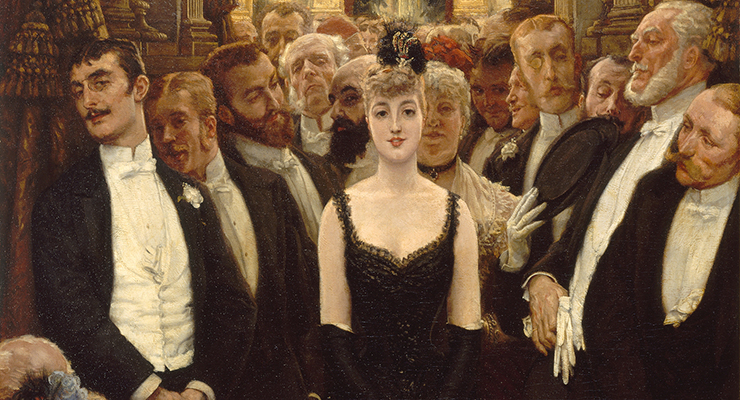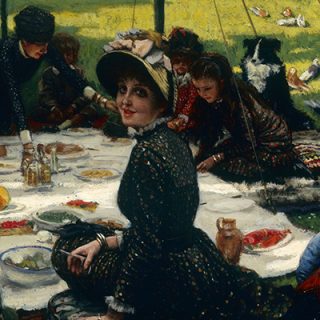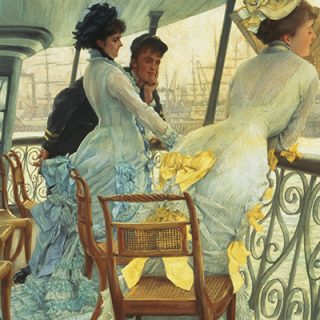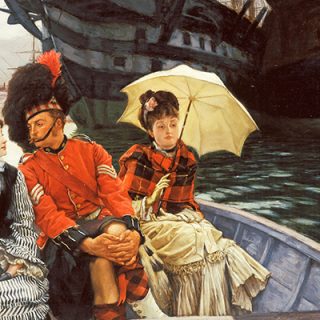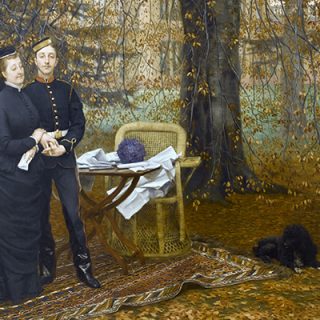dal
26
Settembre
JAMES TISSOT
26 Settembre 2015 / 21 Febbraio 2016
James Tissot
Chiostro del Bramante, Roma
For the first time in Italy, the eagerly awaited exhibition on the great French painter James Tissot (Nantes, 1836 – Buillon 1902). Finally, the artist’s works can be admired at the Chiostro del Bramante in Rome from 26 September 2015 – 21 February 2016, following the major exhibitions devoted to him throughout the world. These include ‘James Tissot’ at the Petit Palais (Paris – 1985), ‘Victorian Life Modern Love’ (Yale Center for British Art, New Haven, Connecticut – Musée du Québec, Québec City, Canada – Albright-Knox Art Gallery, Buffalo, New York, between 1999 and 2000), ‘James Tissot et ses Maîtres’ at the Musée des Beaux-arts in Nantes (2005) and lastly ‘The Life of Christ’ at the Brooklyn Museum of Art (2009). A refined leading figure in the elite of his time, both envied and loved, James Tissot is a painter whose art in some respects is still an enigma today, a blend of Impressionist influences and Pre-Raphaelite echoes. Tissot was French by birth but British by adoption and felt equally at ease among conservatives and liberals. His paintings celebrate the life of the upper middle class – the class that was at its height during the Victorian era between the industrial revolution and colonialism – by transforming the quotidian into heroic and celebratory exploits, turning every gesture into a stereotype, but one that was not devoid of originality.
DART – Chiostro del Bramante and Arthemisia Group, under the Patronage of the Department of Culture and Tourism of the Rome City Council, are firmly convinced of the need to present this still little known artist to the Italian public. The 80 works in the exhibition, including paintings and engravings, span his whole artistic trajectory. They show how he was influenced both by the Parisian art scene and the real world of London, whilst illustrating his romantic and mystical vein, his incredible talent as a colourist and his interest in fashion. Among the works displayed are such masterpieces as The Captain’s Daughter and The Warrior’s Daughter, both from 1873, alongside the Gallery of HMS Calcutta (1886). They illustrate the principal themes of Tissot’s art, which he always addressed with profound psychological insight, and testify to his talent as a colourist and keen observer of his times.
THE ARTIST
The son of the drapery merchant, Marcel Théodore, and a milliner and designer of hats, Marie Durand, – hence his skill in depicting details of dress – Tissot was part of the movement of Realism, alongside Courbet, Daumier and Millet, that developed in France in 1840. His French name Jacques Joseph, which he later anglicized, sums up the historical and artistic influences of his art. In the beginning he made mainly history paintings, influenced by the Dutch school, which were well received by the critics when they were exhibited at the Salon of the Louvre in 1859. Soon, however, Tissot turned to depicting the places and personalities of Parisian high society and was a master in rendering female charms. His portraits are so precise and realistic they almost seem like photographs. In fact, the dresses and accessories are faithfully depicted with great attention to detail and in revealing the tastes of the aristocracy they flaunt the social status of his subjects. This was the period in which Tissot, following the teaching of Ingres and in tune with the future Impressionists, broke away from the French tradition and became a model of modernism and the emblem of that intellectual atmosphere that surrounded him, by establishing himself as one of the most talented portraitists of his generation. His paintings were used for the covers of books and magazines. In 1873 Tissot decided to move to London and escape from the horrors of Paris after the Franco – Prussian War, the siege of the city (1870–71) and the barbarous mass executions that took place right near his house. He accepted some commissions from friends in England and produced works conceived especially for the English market, to be sold and exhibited. In London he took up engraving, drew caricatures, painted portraits and subjects characterized by their realistic style and soft colours. He began to depict social events, their settings and personalities, and he was often accused of “hyperrealism”. In 1876 he met Kathleen Newton, a young Irish woman with a story of adultery behind her. When she returned to London after divorcing her husband, an officer in the English army, she was excluded from respectable Victorian high society. Kathleen became Tissot’s model and mistress, and his love for her meant that he stopped frequenting the London drawing rooms. She had consumption and committed suicide in 1882. Tissot never recovered from the loss. He sold the house in London to Alma Tadema and returned to Paris. The mystical crisis that was the consequence of his grief for Kathleen left its mark on his art. His definitive conversion to Catholicism led him to spend the rest of his life making Bible illustrations and he travelled in the Middle East and Palestine for ten years. When he came back to France, he worked on a series of subjects from the Old Testament that he never finished; 80 of these works were exhibited in Paris in 1901, a year before he died suddenly in August 1902. Tissot enjoyed considerable success in his lifetime. In the 1980s English critics definitively recognized the value of his work. The French staged major solo exhibitions (from the show at the Petit Palais, Paris, in 1985, to the one at the Musée des Beaux-Arts, Nantes, in 2005) to present this artist who was so famous in England but had so far been neglected in France. In recent decades, other exhibitions organized throughout the world have enabled scholars to more accurately date and determine a chronology of his works, particularly in relation to the social and cultural implications of his poetics.
THE EXHIBITION
Eight thematic sections illustrate the artistic and spiritual trajectory of this artist from Nantes, through a chronological journey that recounts his passions, torments and experiences. Sections One and Two – His Paris Beginnings: a Story Painter Tissot began his career in Paris painting history scenes inspired by the Renaissance. Leave takings (The Departure of the Prodigal Son, 1862), abductions (The Attempted Abduction, 1865), duels and games of seduction The Meeting of Faust and Marguerite, 1860, reflect his interest in dramatic subjects in which the female figure takes centre stage (An Interesting Story, c. 1872), seen as an object of desire, always mysterious and unattainable. Tissot’s participation in the Paris Salons was a success, so much so that he was now wealthy and had a mansion built in Paris.
Section Three – Modern Life | During this period he began to collect Japanese art, which influenced his work (Japanese Girl Bathing, 1864), he befriended Whistler and Degas, made many portraits – including Portrait of Miss L.L. (1864) which shows a change in his style – and was always interested in the high life. In 1869 he produced caricatures of the English elite and in 1870 – when the Franco-Prussian War broke out – he executed a series of works that reveal a different image of the artist, a Tissot who was more involved in the political debates of the day than had ever been thought.
Section Four – A London Painter | His arrival in London after the surrender of the Paris Commune on 28 May 1871 gave him the opportunity to establish a cosmopolitan clientele and to frequent personalities like Millais, Hayden, Alma-Tadema, Heilbuth and De Nittis. During the eleven years he spent in the city (1871–1882) he devoted himself mainly to portraits and other subjects – (The Portrait of the Empress Eugénie and the Prince Imperial 1874; Miss Lloyd, 1876), The Captain’s Daughter (1873), Portsmouth Arsenal (1876), and the extraordinary Gallery of HMS Calcutta (1886) – that testify to his talent as a colourist and keen observer of life. In the works of this period the customs of the British capital are described with irony (The Warrior’s Daughter, 1873) and the codes of Victorian society are ridiculed in paintings with double-entendres. In London Tissot also began to make engravings so that he could duplicate and circulate his most successful works.
Section Five – Kathleen Newton | The Ideal Face In voluntary exile, Tissot was extremely sensitive to the social issues of the time. Despite his wealth and egoism, often criticized by his contemporaries, he showed concern for the disadvantaged classes, the poor and women, whom he observed closely. He fell in love with Kathleen Newton, a stunningly beautiful Irish divorcee, and invited her and her children to live with him in the house in St John’s Wood, which then became their family home. Kathleen was Tissot’s muse and – by posing according to stereotypes – she became the mysterious woman (Reading a Story, 1881) or the melancholy female (Seaside, 1880), the woman in the hands of fate (A Convalescent, 1880–1882) or the femme fatale proud of her femininity (Mrs Newton with a Parasol 1878–1880). During this period (1875) Tissot devoted himself to engraving. He frequented the Hanover Square Club in London, where he met the engravers Frederick Goulding and Seymour Haden, and also the Italian Giuseppe de Nittis. The latter was one of the new generation of artists who worked between Paris and London, and who – like Tissot – brought a lyricism to the show of both female and Parisian elegance and the scintillating and refined atmosphere that reigned in high society. Section five of the exhibition features five works by the great Italian artist, including Lady Seen from Behind in the Garden (1883), Lady in the Garden, and In the Snow (1875). They all convey the incisive personality of De Nitttis – dubbed the “painter of Parisiennes” by the critics of his day – and explore the social and fashionable milieus that inspired De Nittis and Tissot.
Section Six – The Warrior’s Daughter | Tissot was a keen observer of London life. In 1879 he painted The Warrior’s Daughter, an original, detailed description of the British lifestyle of the period. In the painting a young woman – who resembles Kathleen – accompanies her old father in a wheel chair, with Cumberland Terrace, Regent’s Park, an elegant area in London, in the background. The image could be a tribute to a war hero if the young woman’s penetrating gaze were not directed at the viewer. She is the real protagonist of the painting, and not even the luxurious details of the rug over the male figure’s legs, the fur and the tartan coat can compete with her. Often accused by colleagues of rendering his subjects with scorn and sarcasm, here Tissot challenges the viewer with biting irony. The contrast between the paternal figure – as grey and austere as the Victorian terrace in the background – and the elegant young woman – whose beauty is offset by the brooch she is wearing – is disturbing. But not to her elderly father, who is oblivious to the fact that his daughter has an inner life and is probably thinkng about love that is in no way filial.
Section Seven – The Prodigal Son in Modern Life | Tissot considered himself a “prodigal son” all his life, and this is a theme that recurred in his oeuvre, sometimes after a gap of several years, between 1862 and 1880. When he became more religious after meeting Kathleen, Tissot began to lead a quieter life. After his partner’s death, when he was back in Paris he became increasingly depressed and beset by doubts. In this period he completed the second cycle of paintings on the theme of the prodigal son, this time in a modern setting. After twenty years he reprised the same Christian parable, but in a darker vein reflecting the difficulties of life.
Section Eight – Inward Journey and Departure | After Kathleen’s untimely death in 1882, when she was only 28, Tissot decided to return to Paris and his career as an itinerant artist. He had always been a great traveller, he was originally from Nantes and therefore used to the coming and going of ships in the port, and he often addressed the theme of departure in paintings featuring railway platforms and quays. The Widower (1876) is a splendid allegory of departure seen as the prelude to a new future. As in a kind of self-portrait the artist anticipates the death of his partner, while the child symbolizes the hope that makes it possible to start a new life.
Section Nine – James Tissot, Painter of Fashion | Scholars have long drawn attention to the fact that Tissot was influenced by Impressionism. Though he never exhibited with the Impressionists, he was very aware of the movement’s research. As a friend of Degas, Whistler, Legros and Manet, Tissot supported all the battles fought at the time against academicism. His exhibitions at the Grosvenor Gallery in London gave him the opportunity to come into contact with the Pre-Raphaelites, but also with the artistic elite of the day. The paintings of this period show a certain kinship with the works of Manet, Degas and Toulouse-Lautrec. In the Women of Paris series 1883–85 he develops his view of the modern world: from Ladies of the Chariots, 1885, to The Most Beautiful Woman in Paris, 1883–85, The Mysterious Woman and The Artists’ Wives, 1883-85, Tissot succeeds in painting an extraordinary portrait of the typical Parisienne and fully participates in the artistic and literary debates of the time. His friends Maupassant, Goncourt, Daudet and Halévy considered him a very special painter, brilliant and unclassifiable.
INFORMATION AND BOOKINGS | T +39 06 916 508 451
TICKET ON-LINE | www.ticket24ore.it/tissot
ADMISSION
Monday – Friday 10am – 8pm (last admission 7pm)
Saturday – Sunday 10am – 9pm (last admission 8pm)
PROMO | Monday University
– For university students entry to the special price of € 5.00 (instead of € 13.00) showing:
– BOOKLET UNIVERSITY or COPY PAYMENT FEES UNIVERSITY Academic Year in progress or RECEIPT OF UNIVERSITY Academic Year in progress
AUDIOGUIDE FREE
Last Monday: February 15, 2016, hours 10:00 am to 8:00 pm [The ticket office closes at 7.00 pm]
SPECIAL OPENINGS
November 1, 10:00 am to 9:00 pm
December 8, 10:00 am to 8:00 pm
December 24, 10:00 am to 5:00 pm
December 25, 4:00 pm to 9:00 pm
December 26, 10:00 am to 9:00 pm
December 31, 10:00 am to 6:00 pm
January 1, 10:00 am to 9:00 pm
January 6, 10:00 am to 9:00 pm
* (The ticket office closes one hour before)
TICKETS
– Full Price € 13,00 (audio guide included)
– Reduced € 11.00 (audio guide included): Senior citizens over 65 years (with valid ID); young people 11-18 years (with valid ID); students under 26 years (with valid ID); forces of law and order and the military with valid ID; Disabled visitors; Journalists with regular license of the National Order (professional, practitioner, freelance)
– Reduced price for Groups € 10.00 (booking required min 15 max 25 pax, miking required)
– Reduced price for Children € 5.00 (children 4 to 11 years old)
– Reduced price for Schools € 5.00 (booking required min 15 max 25 pax)
– Reduced kindergarten € 3.00 (booking required min 15 max 25 pax)
– Special Reduction € 9,00 (audioguide included): Guides with ID cards if they do not accompany a group;
– Free admission for (audio guide included): Children under 4; 1 person accompanying each booked group; Teachers accompanying students (2 each groups); ICOM card holders; Free admission for the person accompanying the disable visitors; Arthemisia Group Vip card holders; Amici del Chiostro del Bramante card holders; Journalists (professional, practitioner, freelance) with prior request by the editors sent to press@arthemisia.it – n. 1 journalist warhead; do not we trust the press on Saturday, Sunday and holidays.
DIDACTIC SERVICES | didattica@arthemisia.it
PRESS OFFICES
– Arthemisia Group
press@arthemisia.it | T +39 06 69380306
– Chiostro del Bramante
Raffaele Brancato | info@chiostrodelbramante.it | T + 39 06 68809035
Annalisa Esposito | variazioni@chiostrodelbramante.it
SAN VALENTINE, 14, February
Sunday, February 14, 2016 from 10.00 am to 9.00 pm (ticket office closes at 8.00 pm) all lovers can visit the exhibition dedicated to James Tissot with a Special entrance: 2×1 (1 full price and 1 free ticket) .
